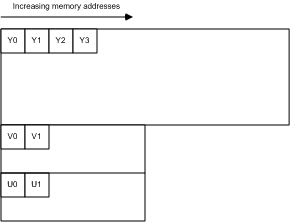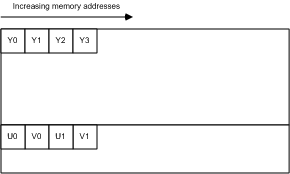【Android】YUV使用总结 —— Android常用的几种格式:NV21/NV12/YV12/YUV420P的区别
工作问题接触到图像这一块,需要对手机摄像头采集的原始帧做Rotate或者scale,但无奈对此的了解少之又少,于是网上搜了一顿,完事后将最近所学总结一下,以方便之后的人别踩太多坑。
首先想要了解YUV为何物,请猛戳: https://msdn.microsoft.com/en-us/library/aa904813(VS.80).aspx
上面的链接中,微软已经写的很详细了,国内大部分文章都是翻译这篇文章的,如果还有疑问的同学可以参考下面这些大神的博客:
- 最简单的基于FFmpeg的libswscale的示例(YUV转RGB) http://blog.csdn.net/leixiaohua1020/article/details/42134965
- 图文详解YUV420数据格式 : http://www.cnblogs.com/azraelly/archive/2013/01/01/2841269.htm
- ANDROID 高性能图形处理: http://tangzm.com/blog/?p=18
看完上面的文章应该都会有所了解和认识了,因为在Android API <= 20(Android5.0之前的版本)中Google支持的Camera Preview Callback的YUV常用格式有两种:一个是NV21,一个是YV12,在此针对这两种格式做分析。
NV21:
先贴一段微软的叙述:
4:2:0 Formats, 12 Bits per Pixel
Four 4:2:0 12-bpp formats are recommended, with the following FOURCC codes:
- IMC2
- IMC4
- YV12
- NV12
In all of these formats, the chroma channels are subsampled by a factor of two in both the horizontal and vertical dimensions.
YV12
All of the Y samples appear first in memory as an array of unsigned char values. This array is followed immediately by all of the V (Cr) samples. The stride of the V plane is half the stride of the Y plane, and the V plane contains half as many lines as the Y plane. The V plane is followed immediately by all of the U (Cb) samples, with the same stride and number of lines as the V plane (Figure 12).

Figure 12. YV12 memory layout
NV12
All of the Y samples are found first in memory as an array of unsigned char values with an even number of lines. The Y plane is followed immediately by an array of unsigned char values that contains packed U (Cb) and V (Cr) samples, as shown in Figure 13. When the combined U-V array is addressed as an array of little-endian WORD values, the LSBs contain the U values, and the MSBs contain the V values. NV12 is the preferred 4:2:0 pixel format for DirectX VA. It is expected to be an intermediate-term requirement for DirectX VA accelerators supporting 4:2:0 video.

Figure 13. NV12 memory layout
从上可知YV12和NV12所占内存是12bits/Pixel,因为每个Y就是一个像素点,注意红色加粗的叙述,YUV值在内存中是按照 数组 的形式存放的,而由于YV12和NV21都是属于planar格式,也就是Y值和UV值是独立采样的:
In a planar format, the Y, U, and V components are stored as three separate planes.
既然Y、U、V值都是独立的,那就意味着我们可以分别处理相应的值,比如在YV12中,排列方式是这样的,每4个Y共用一对UV值,而U、V值又是按照如下格式排列(下面是YV12格式中,宽为16,高为4像素的排列) :
Y第一行:| Y Y | Y Y | Y Y | Y Y |
Y第二行:| Y Y | Y Y | Y Y | Y Y |
--------------------------------------------------------------
Y第三行:| Y Y | Y Y | Y Y | Y Y |
Y第四行:| Y Y | Y Y | Y Y | Y Y |
--------------------------------------------------------------
V第一行: V0 V1 V2 V3 |
U第一行: U0 U1 U2 U3 |
--------------------------------------------------------------
V第二行: V4 V5 V6 V7 |
U第二行: U4 U5 U6 U7 |
--------------------------------------------------------------
16x4像素的YV12排列
知道了YUV值的结构,我们就可以任性的对此图像做Rotate,scale等等。这里我以480*270 (16:9)的一张原始帧图像举例,贴出部分代码示例:
/** * 获取preview的原始帧: * * 这里有个前提,因为Android camera preview默认格式为NV21的,所以需要 * 调用setPreviewFormat()方法设置为我们需要的格式 * */ @Override public void onPreviewFrame(byte[] data, Camera camera) {// 假设这里的data为480x270原始帧 String SRC_FRAME_WIDTH = 480; String SRC_FRAME_HEIGHT = 270; String DES_FRAME_WIDTH = 480; String DES_FRAME_HEIGHT = 270; // 此处将data数组保存在了指定的路径,保存类型为jpeg格式,但是普通的图片浏 // 览器是无法打开的,需要使用RawView等专业的工具打开。 saveImageData(data); // 定义与原始帧大小一样的outputData,因为YUV420所占内存是12Bits/Pixel, // 每个Y为一个像素8bit=1Byte,U=2bit=1/4(Byte),V=2bit=1/4(Byte), // Y值数量为480*270,则U=V=480*270*(1/4) byte[] outputData = new byte[DES_FRAME_WIDTH * DES_FRAME_HEIGHT * 3 / 2]; // call the JNI method to rotate frame data clockwise 90 degrees YuvUtil.DealYV12(data, outputData, SRC_FRAME_WIDTH, SRC_FRAME_HEIGHT, 90); saveImageData(outputData); } } // save image to sdcard path: Pictures/MyTestImage/ public void saveImageData(byte[] imageData) { File imageFile = getOutputMediaFile(MEDIA_TYPE_IMAGE); if (imageFile == null) { return; } try { FileOutputStream fos = new FileOutputStream(imageFile); fos.write(imageData); fos.close(); } catch (FileNotFoundException e) { e.printStackTrace(); Log.e(TAG, "File not found: " + e.getMessage()); } catch (IOException e) { e.printStackTrace(); Log.e(TAG, "Error accessing file: " + e.getMessage()); } } public static File getOutputMediaFile(int type) { File imageFileDir = new File(Environment.getExternalStoragePublicDirectory(Environment.DIRECTORY_PICTURES), "MyTestImage"); if (!imageFileDir.exists()) { if (!imageFileDir.mkdirs()) { Log.e(TAG, "can't makedir for imagefile"); return null; } } // Create a media file name String timeStamp = new SimpleDateFormat("yyyyMMdd_HHmmss").format(new Date()); File imageFile; if (type == MEDIA_TYPE_IMAGE) { imageFile = new File(imageFileDir.getPath() + File.separator + "IMG_" + timeStamp + ".jpg"); } else if (type == MEDIA_TYPE_VIDEO) { imageFile = new File(imageFileDir.getPath() + File.separator + "VID_" + timeStamp + ".mp4"); } else { return null; } return imageFile; } 上面的代码中可以看到我调用了Jni的方法:YuvUtil.RotateYV12();
YuvUtil.java
public class YuvUtil { // 初始化,为data分配相应大小的内存 public static native void initYV12(int length, int scale_length); public static native void DealYV12(byte[] src_data, byte[] dst_data, int width, int height, int rotation); } 对应的Jni的C代码如下:
com_example_jni_YuvUtil.h
/* DO NOT EDIT THIS FILE - it is machine generated */ #include <jni.h> /* Header for class _Included_com_example_jni_YuvUtil */ #ifndef _Included_com_example_jni_YuvUtil #define _Included_com_example_jni_YuvUtil #ifdef __cplusplus extern "C" { #endif /* * Class: com_example_jni_YuvUtil * Method: initYV12 * Signature: (II)V */ JNIEXPORT void JNICALL Java_com_example_jni_YuvUtil_initYV12 (JNIEnv *, jclass, jint, jint); /* * Class: com_example_jni_YuvUtil * Method: DealYV12 * Signature: ([B[BIIIII)V */ JNIEXPORT void JNICALL Java_com_example_jni_YuvUtil_DealYV12 (JNIEnv *, jclass, jbyteArray, jbyteArray, jint, jint, jint, jint, jint); #ifdef __cplusplus } #endif #endif com_example_jni_YuvUtil.c
#include "com_example_jni_YuvUtil.h" #include <android/log.h> #include <string.h> #include <jni.h> #include <stdlib.h> #define TAG "jni-log-jni" // 这个是自定义的LOG的标识 #define LOGD(...) __android_log_print(ANDROID_LOG_DEBUG,TAG ,__VA_ARGS__) // 定义LOGD类型 #define LOGI(...) __android_log_print(ANDROID_LOG_INFO,TAG ,__VA_ARGS__) // 定义LOGI类型 #define LOGW(...) __android_log_print(ANDROID_LOG_WARN,TAG ,__VA_ARGS__) // 定义LOGW类型 #define LOGE(...) __android_log_print(ANDROID_LOG_ERROR,TAG ,__VA_ARGS__) // 定义LOGE类型 #define LOGF(...) __android_log_print(ANDROID_LOG_FATAL,TAG ,__VA_ARGS__) // 定义LOGF类型 char *input_src_data, *output_src_data, *src_y_data, *src_u_data, *src_v_data, *dst_y_data, *dst_v_data; int src_data_width, src_data_height, len_src; /* * Class: com_example_jni_YuvUtil */ JNIEXPORT void JNICALL Java_com_example_jni_YuvUtil_initYV12 (JNIEnv *env, jclass jcls, jint length, jint scaleDataLength) { len_src = length; len_scale = scaleDataLength; LOGD("########## len_src = %d, len_scale = %d /n", len_src, len_scale); input_src_data = malloc(sizeof(char) * len_src); LOGD("########## input_src_data = %d /n", input_src_data); src_y_data = malloc(sizeof(char) * (len_src * 2 / 3)); src_u_data = malloc(sizeof(char) * (len_src / 6)); src_v_data = malloc(sizeof(char) * (len_src / 6)); dst_y_data = malloc(sizeof(char) * (len_src * 2 / 3)); dst_u_data = malloc(sizeof(char) * (len_src / 6)); dst_v_data = malloc(sizeof(char) * (len_src / 6)); } JNIEXPORT void JNICALL Java_com_example_jni_YuvUtil_DealYV12 (JNIEnv *env, jclass jcls, jbyteArray src_data, jbyteArray dst_data, jint width, jint height, jint rotation, jint dst_width, jint dst_height) { src_data_width = width; src_data_height = height; // 将src_data的数据传给input_src_data (*env)->GetByteArrayRegion (env, src_data, 0, len_src, (jbyte*)(input_src_data)); /*以下三个memcpy分别将Y、U、V值从src_data中提取出来,将YUV值分别scale或者rotate,则可得到对应格式的图像数据*/ // get y plane memcpy(src_y_data, input_src_data , (len_src * 2 /3)); // get u plane memcpy(src_u_data, input_src_data + (len_src * 2 / 3), len_src / 6); // get v plane memcpy(src_v_data, input_src_data + (len_src * 5 / 6 ), len_src / 6); /*获取yuv三个值的数据可以做相应操作*/ // ......... // ......... // 例:将Y值置为0,则得到没有灰度的图像; memset(input_src_data + src_data_width * src_data_height, 0, src_data_width * src_data_height); // 将input_src_data的数据返回给dst_data输出 // output to the dst_data (*env)->SetByteArrayRegion (env, dst_data, 0, len_src, (jbyte*)(input_src_data)); } /** * free memory */ JNIEXPORT void JNICALL Java_com_example_jni_YuvUtil_ReleaseYV12 (JNIEnv *env , jclass jcls) { free(output_src_data); free(input_src_data); } 注意:以上代码不是完全的,只是用于说明而已,如果需要更多的操作还请各位朋友自己完善,因为没怎么写过这类博客,很多地方很乱,表述的不清楚,有问题的朋友可以问我。











![[HBLOG]公众号](https://www.liuhaihua.cn/img/qrcode_gzh.jpg)

